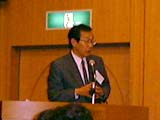![]()
| S-9-11 Proteoglycans as biomaterials |
| Takehisa Matsuda Dept. Biomedicalengineering, Graduate School of Medicine, Kyushu University, Maidashi 3-1-1, Higashi-ku, Fukuoka 812-8582, JAPAN |

![]()
Chemically or physically treated proteoglycans have been finding various applications including pharmaceutical, medical and cosmetic fields. Important medical applications include wound healing technology, prosthetic and biomedical devices. The incorporation of chemical functional groups into proteoglycans produces new functional proteoglycans as biodegradable, bioresorbable biomaterials while maintaining its own biofunctional activity.
The author's approaches are
1) surface immobilization of or fixation of heparin or artificial device or extracorporeal circulatory system provided antithrombogenic activity using heparin partially derivatized with photoreactive phenylazide, grafted with thermoresponsive water-soluble polymer or endcapped with alkyl group.
2) In situ hydrogelation or hydrogelled film using hyaluronic acid partially derivatized with photodimerizable groups such as cinnamate or thymine ensured tissue adhesion prevention.
3) Ant-proliferative agent which is an alkylated heparin reduced intimal hyperplasia as applied for percutaneous treatment. The local delivery of alkylated heparin into diseased sites of vessels minimized thrombus formation, prolonged residence in tissues, and tissue permeation.
These chemically modified heparin and hyaluronic acid function well by appropriate treatments such as photo-irradiation or thermal treatments, resulting in gelation on living tissues as well as fabricated artificial organs.
![]()